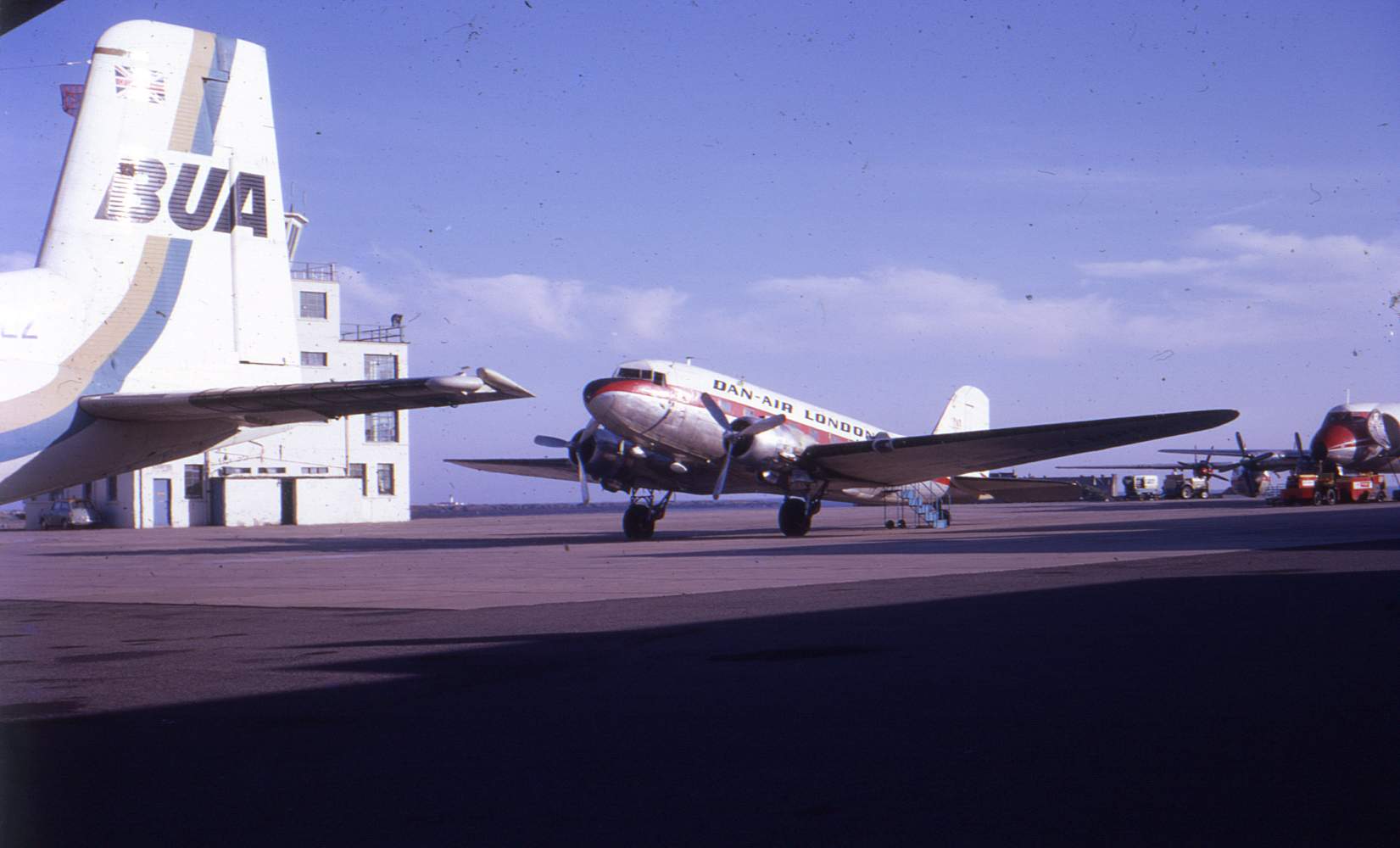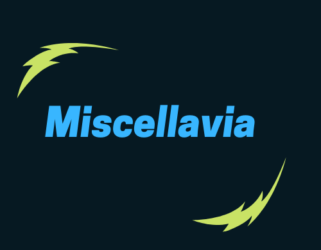Career Highlights: 1943 to present day
* Took part in Operation Overlord with 233 Squadron, June 5th/ 6th 1944 carrying paratroopers to Normandy.
* Flew casualty evacuation flights between France and Britain from June 16th onwards.
*Regular pilot was Flying Officer R.R.C.Hyne, later Flt. Lt., who flew KG403 on Operation Tonga, Market Garden and Varsity.
* Towed a Horsa glider to Arnhem on September 17th and resupply missions on 19th and 23rd.
* Was part of 233’s ‘B’ flight detachment to Nivelles, Belgium in early 1945. Recorded as having ‘hit a tree’ mid February 1945, but was soon back in operation.
* Towed a Horsa glider on Operation Varsity Rhine Crossing.
* Prominent in delivering fuel to advancing allied forces, returning with casualties and, later, ex-Prisoners of War.
* Flew large number of logistics flights to France, Belgium, later Germany plus occasional missions to Lyon, France, and Scandanavia.
*May have been the final aircraft flown by 233 Squadron Commanding Officer, Wing Commander Mellor, before he changed post.
* May have taken part in transfer of 233 Squadron to Imphal, India. Certainly joined RCAF Squadron 436 subsequent to their transfer from India to England.
*Transferred to Canada in 1946 and served with successive units, ending up with training units and Technical Services. Demobbed at end of 1971.
*Joined the Canadian register briefly as CF-BKP before moving to US register as N107AD in May 1972 with Aerodyne in the Pacific NW.
* Flew with Alaskan fish transporters Stannelco, then Seattle’s Salair.
*Joined New England parcel delivery company Business Air in 1986.
*Moved to Champlain Air, re-registered N700CA in May 1992.
*Bought by Basler around 2013 for conversion to BT-67. Work started in 2022 and KG403 will be rejuvenated as Basler airframe #71.
MILITARY CAREER:
KG403, construction number 12438, was built in Oklahoma City as 42-108859 for the USAAF and delivered on 4th February 1944 (1). Supplied to the RAF under Lend/ Lease, the Dakota III arrived at RAF Dorval, Montreal, on February 13th and had crossed the Atlantic by February 26th. The Dakota is recorded as joining 233 Squadron three days later on February 29th 1944 (a Leap Year). It seems likely that KG403 was delivered to 233 at their Gosport facility for initial preparation but it is possible that she went directly to RAF Bircham Newton in Norfolk. Either way, the main party of the Squadron arrived at their new home at Blakehill Farm on March 5th and, two days later, twelve Dakotas arrived for conversion training. KG403 would have been one of these and familiarisation training continued throughout March at Blakehill as the aircraft were fitted-out for airborne operations.
Training for Operation Overlord was commenced and continued during April 1944 as further crews arrived from conversion training. Exercises in pannier dropping, parachute dispatch, precision navigation and day/ night formation flying were carried-out using bases such as Netheravon. Glider towing was practiced following the collection of Horsas from Swanton Morley and North Luffenham.
(1) Data on KG403 from Air Britain’s DC1/2/3: the first seventy years by Jennifer Gradidge.
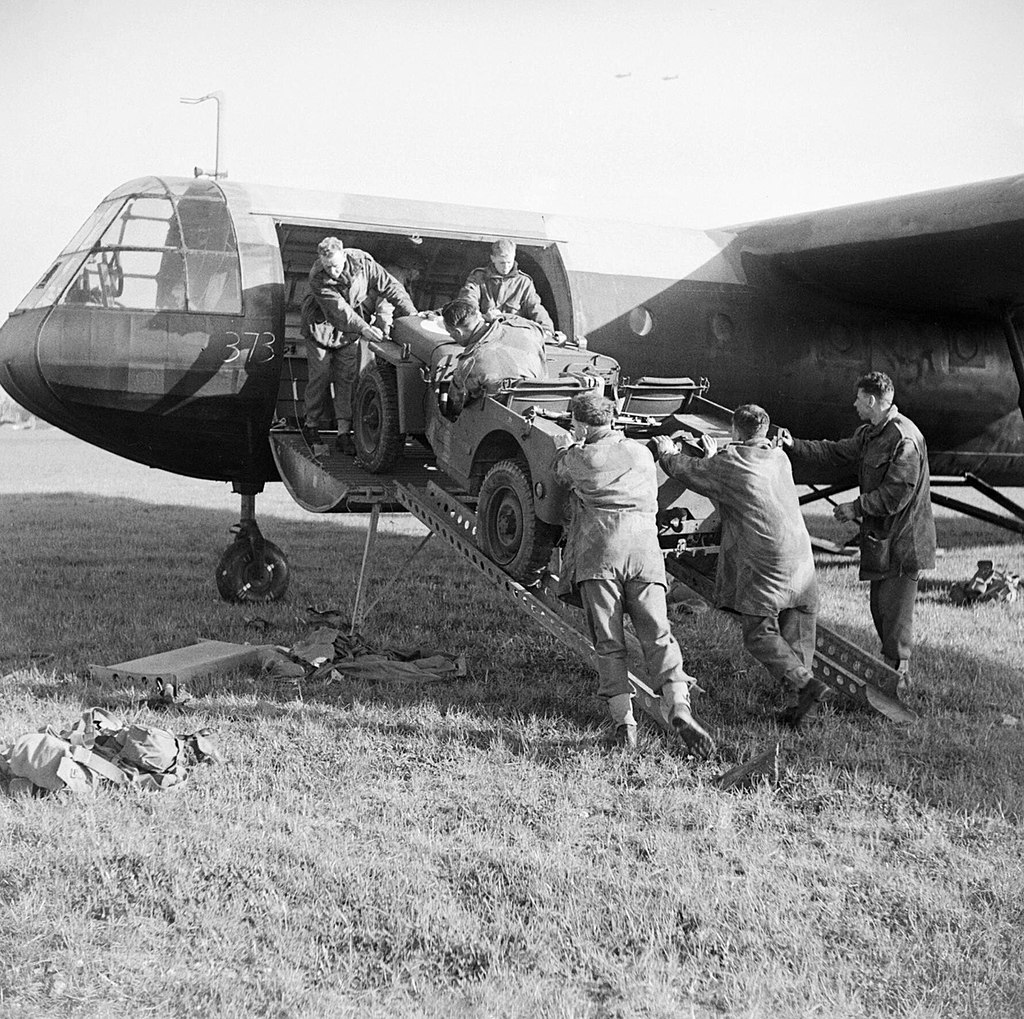
Parachute drops were carried-out at various locations including Netheravon and Stonehenge with the participation of 1st Canadian Parachute Battalion which had been allocated to the training. KG403 would have taken part in these exercises as one of the first Dakotas delivered. By the big exercise of April 22nd, up to 22 of the Squadron aircraft were being flown during the various exercises.
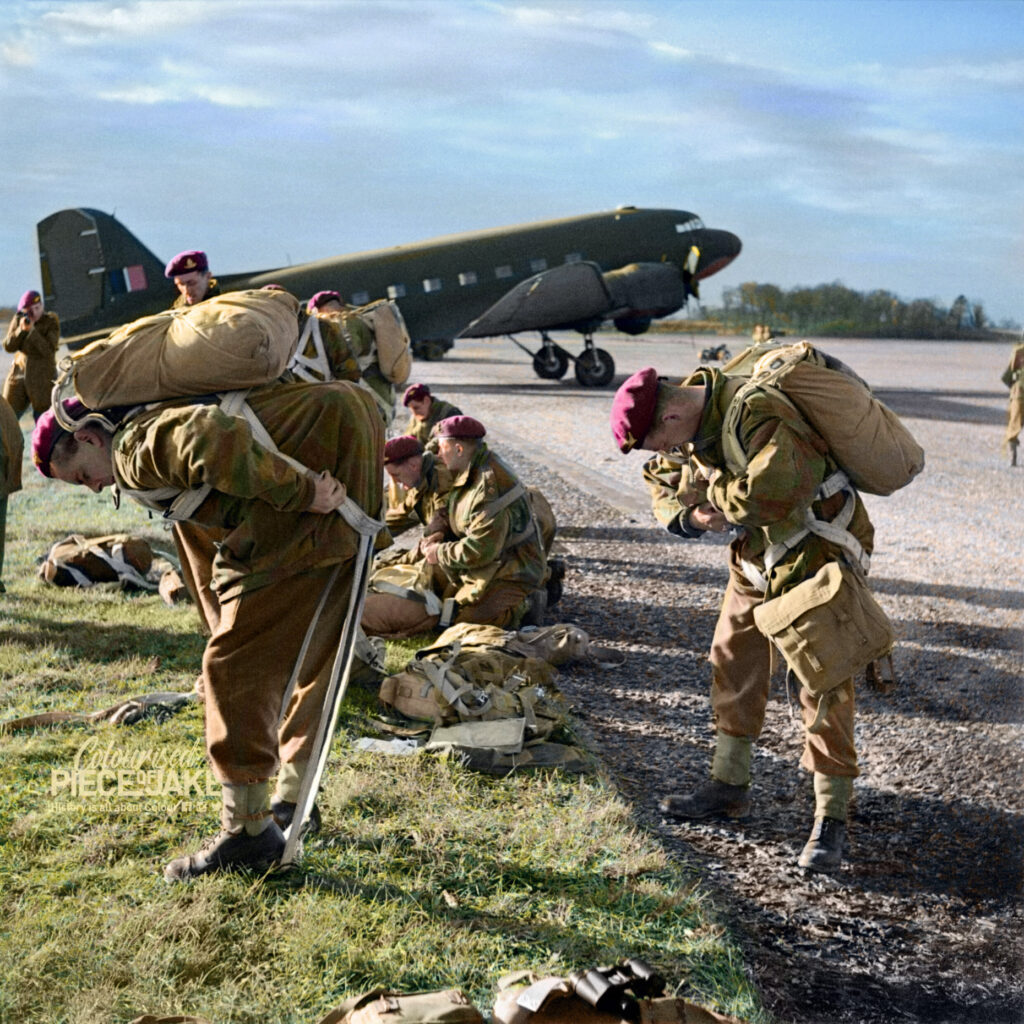
On the night of 25th/ 26th April, 233’s first active mission was carried-out with the Squadron CO, Wing Commander Morrison, flying KG341, at the head of three aircraft on a ‘nickelling’ mission to drop propaganda leaflets over France. KG403 was not part of this first mission but possibly took part in subsequent missions leading-up to Operation Overlord.
On June 2nd 1944, all 233 Squadron Dakotas scheduled to take part in the Normandy landings were air-tested and crew equipment lists checked. Six aircraft were due to tow Horsa gliders to France followed by 24 aircraft carrying paratroops. The target zone ‘K’ at Toufreville was assigned to 233 Squadron for Operation and the airborne troops would be the 8th Parachute Battalion of the 6th Airborne Division.
KG403 was one of the 24 aircraft carrying paratroopers and was captained by Flying Officer R R C Hyne, an officer who would fly KG403 on most major missions. Warrant Officer Evered was the second pilot, Warrant Officer G.Fotheringham the navigator and Flying Officer Knapp the wireless operator. The 24 aircraft began their take-off sequence at 23:11 on June 5th and the operation proceeded successfully with KG403 arriving safely home at Blakehill Farm at 02:40 on June 6th. KG403 didn’t take part in the succeeding re-supply operation, Robroy 1, and remained on active standby until logistics and casualty evacuation flights commenced.
The Allied sappers started work establishing strategic advanced airstrips in Normandy as soon as suitable sites had been gained. The first British landing ground, B1, was just inland from Gold Beach and opened on June 10th. B2/ Bazenville was also a scant 3 miles from Gold Beach and opened the following day, June 11th – slightly later than planned owing to the unplanned arrival of a B-24 a couple of days earlier. KG403 made her first landing on the Continent at Bazenville on June 16th, delivering bombs and, together with four other Dakotas, uplifted 72 stretcher cases and 13 walking wounded. The front line was around five miles distant.
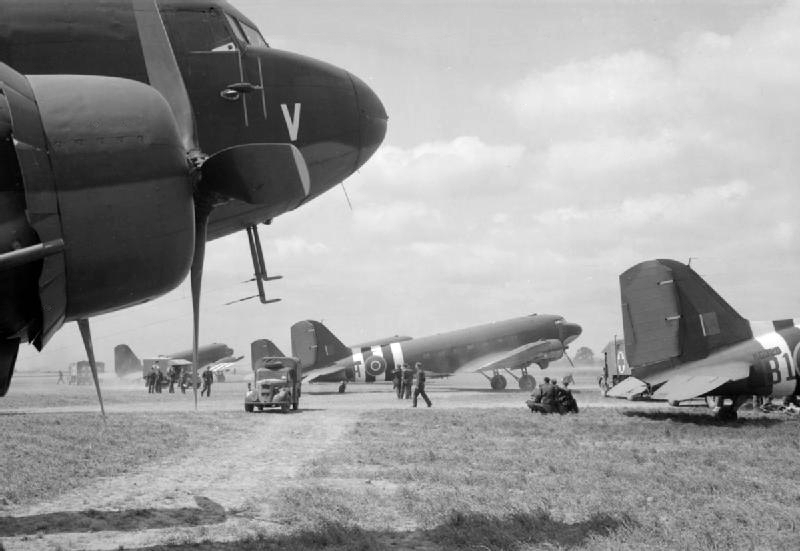
The next mission saw FO Hyne’s crew delivering guns, spare parts, periodicals and ‘comforts’ to the troops at B2 on June 27th. KG403’s last mission in June was on 29th when, again captained by FO Hyne, she was part of a 19-aircraft mission visiting B8/ Sommervieu to the east of Bayeux. KG403 was one of three Dakotas carrying Spitfire propellers and ammunition. A total of 209 stretcher cases and 133 walking wounded was evacuated to Down Ampney. On July 1st, FO Hyne piloted KG403 back to B8/ Sommervieu, accompanying KG410 on a 2-Dakota mission transporting the personnel of 400 Squadron RCAF. This Spitfire-equipped photo reconnaissance unit was being moved from Odiham to the front. Strangely, this was the only mission recorded for KG403 in July, but she was back in action on August 7th when Flt.Lt Burden’s crew carried a load of newspapers from the distribution centre at Thorney Island to B14/ Amblie before returning to Blakehill Farm with casualties. The same mission was repeated just over a week later on 15th when FO Chambers delivered the news to Amblie. On August 19th KG403, flown by FO Dober, was one of fourteen 233 Squadron Dakotas directed to Tangmere to collect 188 personnel of 143 Wing. The passengers were transported to B8/ Sommervieu before the fleet transited to B14/ Amblie to load casualties bound for England. At Amblie, KG403 developed a slow puncture in one tyre and it was decided that only three walking wounded would be carried on the return flight to Blakehill. Four days later, on August 23rd 1944, twenty-three passengers were carried to B21/ St.Honorine on an afternoon flight and KG403 returned home empty. The last August flight saw FO Hyne in command for a food-delivery flight to Orleans, part of 21 233 Squadron Dakotas carrying supplies bound for Paris.
FO Hyne was in command of KG403 for much of the aircraft’s busier September schedule. Logistics flights were combined with casevac operations as the Allies moved rapidly through Europe towards the Rhine. September 4th saw the Hyne crew flying KG403 as part of a 15-Dakota operation carrying members of the Tactical Air Force Communications Squadron from Northolt to A12/ Lignerolles. KG403 was one of the ten Dakotas that remained overnight before uplifting petrol and ammunition from B6/ Coulombs to B50/ Vitry-en-Artois on September 5th. The same crew were on board KG403 on September 10th when 10 Dakotas delivered petrol to B60/ Grimbergen in Belgium. This airfield, just to the north of Brussels, became a regular destination for 233 Squadron and KG403. A delivery of petrol and oil was made there on September 11th and the same products delivered to B60 from Lyneham on September 12th. A mail flight to B14/ Amblie was made on 13th before the Dakota returned to Blakehill to prepare for the Arnhem operation.
On Sunday September 17th, KG403 took-off from Blakehill Farm at 10:00 as one of twenty-two 233 Squadron Dakotas towing Horsa gliders en route to Arnhem with elements of the British First Airborne Division. As usual, FO Hyne was the Pilot in Command, WO Evered the second pilot. The gliders were released successfully to the west of Arnhem and the Squadron returned to Blakehill. The next day WO Green piloted KG403 on a 16-aircraft re-supply mission. The weather was poor on the next day, September 19th, but KG403 carried-out a fuel replenishing mission to Brussels with FO Hamilton at the controls. Flying Officer Hyne’s crew were back in KG403 on September 23rd for a further re-supply mission to Arnhem. The Squadron suffered some serious damage on this flight with nine of the seventeen Dakotas hit by Flak. Fortunately for FO Hyne, KG403 was able to drop the panniers as planned and return to Blakehill. At this stage of the Arnhem mission, there was some doubt as to whether the Allied forces received the supplies dropped by the Squadron.
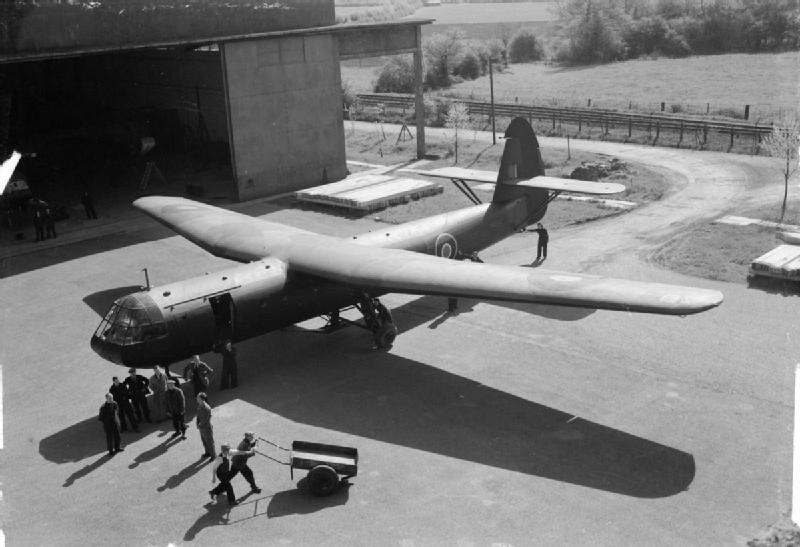
FO Hyne and WO Evered were the pilots for a flight carrying supplies to B56/ Brussels-Evere on September 25th. The eleven Dakotas returned to Down Ampney with a total of 204 evacuated casualties. KG403 was flown to B58/ Brussels-Melsbroek on 26th, carrying ammunition. Once the eight aircraft had been unloaded, Flt.Lt Jenkins hopped KG403 to the highly-congested Brussels-Evere before returning empty to base. On September 27th, FO Hyne’s crew and KG403 took drop tanks to B59/ Ypres as part of an 8 aircraft mission. Later the same day, the same crew flew 403 from Blakehill to Matlaske in Norfolk with ten other 233 Squadron Dakotas which had been tasked with moving air force personnel and equipment to B60/ Grimbergen. The eleven aircraft flew to Grimbergen on the morning of 28th and, after unloading, three Dakotas, including KG403, proceeded to B82/ Grave to uplift personnel for transport back to Blakehill.
Following the failure to capture the bridge at Arnhem, the early part of October was spent consolidating the gains which had been made during Market Garden. KG403 was in action almost every day during the first half of the month.
October 2nd: FO Hyne flew KG403 to B56/ Evere as part of a 17-aircraft armada delivering petrol. 200 lbs of mail was carried on the return leg.
October 3rd: Flt.Lt Jenkins piloted KG403 as one of three Dakotas taking ammunition to B56/ Evere, returning via Netheravon with airborne forces personnel and equipment.
October 4th: A 14-aircraft mission delivered ammunition to B56. FO Hyne flew back to Down Ampney with airborne forces equipment.
October 5th: B56/ Brussels-Evere again with FO Hyne at the controls. KG403 was one of seven Dakotas delivering petrol. Poor weather led to an intermediate stop at B59/ Ypres before continuing to Brussels. Casualties were evacuated to Broadwell on the return flight.
October 6th: Much the same – FO Hyne flew ammunition directly to Brussels as part of a 12-aircraft operation. Casualties to Broadwell.
October 7th: Similar again – 10 aircraft fly ammunition to B56. FO Hyne returns to Blakehill Farm in an empty KG403.
October 8th: KG403 and FO Hyne part of a 13-Dakota mission taking ammunition to B70/ Antwerp. Casevac to Broadwell on the return leg.
October 9th: Flt.Lt Reid captained KG403 on a flight to B17/ Caen carrying mail and passengers. The flight continued to B56/ Brussels where it overnighted before flying home on 10th.
October 11th: Pilot Officer Dijkstra flew KG403 on a 9-aircraft mission delivering lub oil to B56/ Brussels-Evere. Following an overnight stay, the Dakota returned to Down Ampney with evacuated casualties.
October 13th: Warrant Officer Lee flew KG403 as one of five Dakotas carrying 25-pounder ammunition to B58/ Melsbroek, returning empty.
October 18th: Flt.Lt Burden was in command for a flight to B17/ Caen Carpiquet departing Blakehill at 07:50 with 1570 lbs of mail and 2200 lbs of vehicle spares. Another 1770 lbs of mail and 2 passengers were transferred to B58/ Melsbroek and, finally, 3014 lbs of mail flown home.

After a quiet end to October, KG403 was back in action on November 1st with FO Menzies crew flying fourteen passengers from Northolt to B78/ Eindhoven and a further 9 Northolt passengers on to B58/ Brussels- Melsbroek. Overnighting at Brussels, KG403 returned to B78/ Eindhoven the next day with passengers and freight. Sixteen passengers and luggage were then returned from Eindhoven to Northolt. 5th November saw FO Hyne piloting KG403 as part of a 7-aircraft operation delivering freight to B70/ Antwerp. Mail duties were back on the schedule on November 10th when Flt.Lt Burden delivered mail and publications to B58/ Brussels-Melsbroek before continuing to B17/ caen with more mail. The final sector moved mail and three passengers back to Blakehill Farm.
Withe the profusion of advanced landing grounds springing-up across Europe, flights delivering Pierced Steel Planking (PSP) were necessary. On November 12th, FO Hyne piloted KG403 as one of nine aircraft delivering the heavy PSP to B51/ Lille. The following day, Squadron Leader Daniel and KG403 took the same product from Lyneham to Lille. 14th November, it was FO Hyne, KG403 and PSP delivering PSP from Lyneham to B79/ Volkel and, on 15th, a near-identical mission for KG403 and FO Chambers. Flt.Sergeant Morrison took his turn in KG403 for a 4-aircraft mission delivering PSP to Volkel. the same crew and aircraft were part of a 6-Dakota operation carrying PSP to B77/ Gilze-Rijen the following day.
On November 25th Flt.Lt Mackie delivered 3 passengers from Blakehill to B51/ Lille and returned, also with three passengers. A passenger flight was also operated by KG403 on 26th November when Flt.Lt Burden flew 14 passengers from Northolt to B58/ Brussels-Melsbroek. Twenty passengers were carried on the return. The following day it was back to heavyweight operations with FO Merricks and KG403 flying PSP on a 10-aircraft mission to B53/ Merville. Merville was also the destination on November 29th when FO White flew KG403 as part of a 7-Dakota operation carrying munitions. The return sector was flown with sixteen stretcher cases and one walking wounded bound for Broadwell. The last day of the month involved glider towing training in anticipation of the Rhine Crossing in Spring 1945.
On 1st December 1944 Pilot Officer Green departed Blakehill Farm at 10:03 en route to B58/ Melsbroek with army freight. Eleven stretcher cases and thirteen walking wounded were returned to Down Ampney. After a short break, KG403 was in action again on 7th December as one of three 233 Squadron Dakotas delivering RAF equipment from Bicester to B67/ Ursel in Belgium. The next day R.Hyne, by now Flt.Lt Hyne, piloted KG403 as one of nine aircraft delivering army freight to B77/ Gilze-Rijen. The same crew and aircraft flew with 2nd Tactical Air Force stores from Bicester to B58/ Brussels-Melsbroek the following day, returning to Barkston Heath in Lincolnshire (home of 61st TCG, USAAF) with 22 RAF Regiment personnel. Flt.Lt Hyne’s new second pilot was now Flt.Lt Clarke as WO Evered had graduated to being a pilot-in-command. He remained with 233 Squadron until his tragic death on September 12th 1945 when Dakota KJ902 crashed at Tiddim on the India/ Burma border during supply-dropping operations.
Squadron Leader Daniel was in command on December 11th for an 08:30 lift from Blakehill as part of a 7-aircraft operation delivering army stores from Bicester to B53/ Merville. Flt.Lt Hyne’s crew were back with KG403 on 12th December for a 14 aircraft mission taking ammunition to B77/ Gilze-Rijen. On 15th a 6-Dakota operation took army freight to B65/ Maldegem and, after an overnight stay, KG403 returned to Blakehill with passengers. Flt.Lt Hyne delivered oil to the Continent on 17th and Flt.Sgt Morrison flew army freight from Bicester to B50/ Vitry-en-Artois on December 18th.
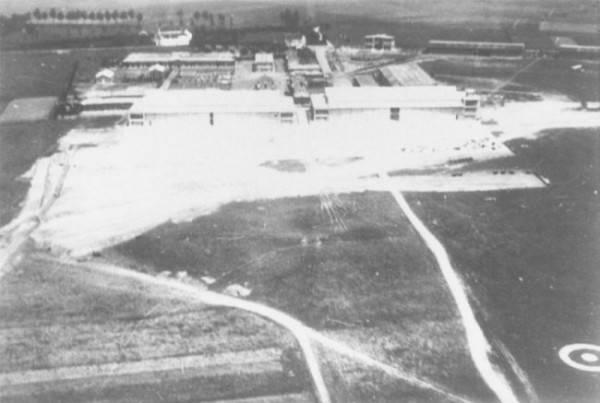
1945 started very differently for KG403: it was one of eight aircraft detached to operate from B75/ Nivelles under 111 Wing control, initially for one month. Twelve crews were assigned to ‘B’ Flight and the cookhouse personnel headed for Belgium on January 1st. KG403, with Flt.Lt.Hyne’s crew was one of seven Dakotas carrying the main body of ‘B’ flight to Nivelles on 3rd January. By January 5th, she was operating on the Brussels-centred operations with FO Dijkstra flying from Nivelles to Melsbroek to collect casualties destined for B56/ Brussels-Evere. An identical operation was performed by Warrant Officer Curtis in KG403 the following day. On January 18th, FO Butcher piloting KG403 and FO Dijkstra in FZ635 collected passengers from B77/ Gilze-Rijen and delivered them to Fairwood Common. KG403 proceeded to Blakehill farm and remained there for three nights. Returning to Brussels, FO Clarke was able to use KG403 on 22nd January to deliver three of ‘B’ flight’s aircraft engineers to B51/ Lille where a 233 Squadron needed repairs. The remedial work was completed by January 24th.
KG403 was back, making short hops around Brussels at the start of February. On 1st February, FO Clarkson ferried KG403 from B56/ Evere to B75/ Nivelles ready for Flt.Lt Burden to take part in a 2-aircraft lift of 10,000 lbs of army freight from B75 to B78/ Eindhoven the following morning, February 2nd. The Dakota was back at Nivelles just after midday and remained there until shuttling the forty kilometres north to Brussels-Evere the following day. KG403 and crew remained on standby for three days, possibly awaiting passengers bound for France. FO A.White departed Evere in KG403 on February 7th bound for Lyon with 17 passengers. The return leg to B56/ Evere was flown the next day with 24 passengers inbound to Brussels. The flight continued from Evere to B78/ Eindhoven with 25 passengers. Five passengers were then returned to Evere before KG403 returned to her Nivelles base.
Passenger flights continued to be important for KG403:0n February 8th, FO Clark flew the Dakota as one of four aircraft carrying a total of 93 passengers from B78/ Eindhoven to B89/ Mill, also in Holland. On 15th, Flt.Lt Hyne’s crew flew KG403 empty to Eindhoven where they remained on the ground overnight before PO Dijkstra flew 21 passengers to Lyon. After a further overnight stop in France, the Dakota returned to Nivelles with 18 passengers. The service to and from Lyon was a regular mission for ‘B’ flight in early 1945.
Flt.Lt Hyne’s next trip in KG403 was an empty positioning flight to B17/ Caen Carpiquet on February 18th to collect 100 lbs of urgent medical supplies for delivery to Nivelles. The return flight was hampered by very poor weather and, on the approach to Nivelles, the operational logs record that the ‘aircraft hit a tree’ and, with some damage, was redirected to Blakehill Farm for repair. Flt.Lt Hyne was back flying from Nivelles on February 22nd but KG403 didn’t return until March 4th when repairs had been completed. On March 5th, Flight Sergeant Butcher flew KG403 from B75/ Nivelles to B78/ Eindhoven with 3750 lbs of army freight. Positioning to B77/ Gilze-Rijen, 6 stretcher cases and 18 walking patients were picked-up and flown to B65/ Maldegem before the Dakota returned to Nivelles. Two days later, six of ‘B’ flight’s Dakotas moved from Nivelles to B56/ Evere with KG403 piloted by Pilot Officer White. March 8th saw FO Dijkstra in command of KG403 for a trip to B77/ Gilze-Rijen where 18 stretcher cases and 8 walking casualties were embarked for the flight to B67/ Ursel. The Dakota returned empty to Evere but was back at Ursel the following morning. Flt.Lt Reid picked-up three passengers destined for B85/ Schijndel before transiting empty to B77/ Gilze-Rijen to collect 8 stretcher cases and two walking wounded bound for B65/ Maldegem. KG403 didn’t fly any further missions before the ‘B’ Flight detachment was transferred back to Blakehill Farm on March 12th with 20,000 lbs of Squadron equipment and 43 personnel.
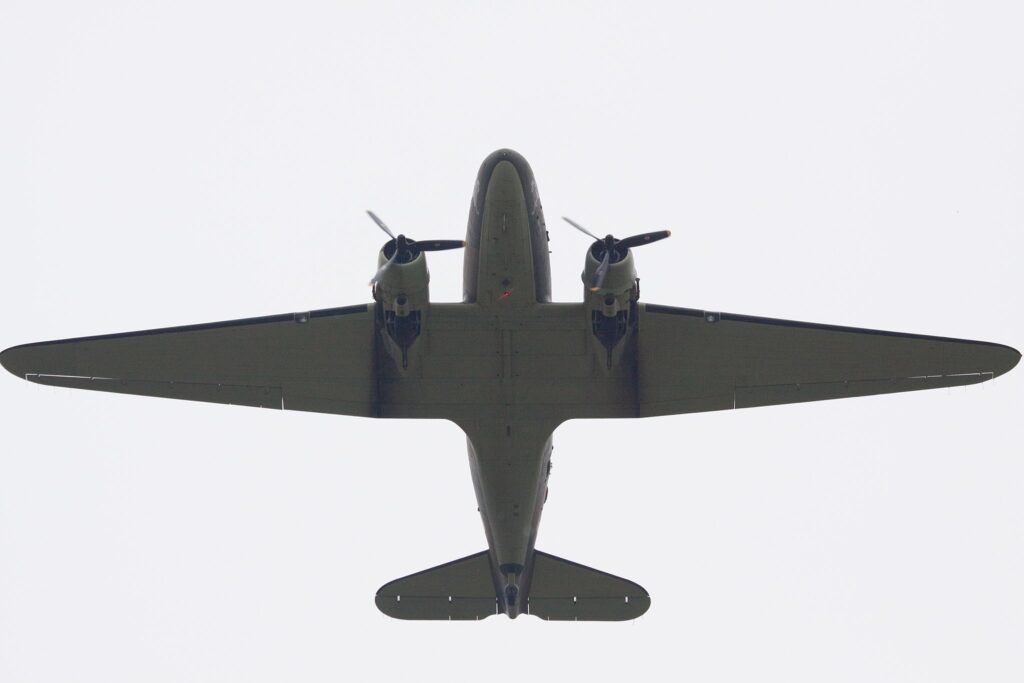
Although the full squadron was now back at Blakehill, Belgium remained an important focus in the build-up to the Allied spring offensive. On March 15th, FO Farquaharson traveled with KG403 to Perranporth in Cornwall, an airfield used to marshal RAF units destined to move to the Continent. KG403 and nine other Dakotas were loaded with freight bound for B56/ Brussels Evere. The following day, March 16th, Flt. Lt Hyne was back in KG403’s cockpit as part of a 2-Dakota mission taking 25 passengers from Fersfield (2) to Evere. 20th March saw KG403 back at Perranporth with PO Green’s crew as a part of a 14-aircraft operation delivering personnel and equipment to Brussels-Evere. KG403 returned to Down Ampney with 4163 lbs of mail.
(2) The Operations Log spells the Norfolk airfield ‘Firsfield’, a facility which had been used for testing remote-controlled B-17 and B-24 bomber drones during 1944. Five days after KG403’s visit to Fersfield, Mosquito VIs of 140 Wing launched their attack on the Copenhagen Gestapo HQ from the airfield.
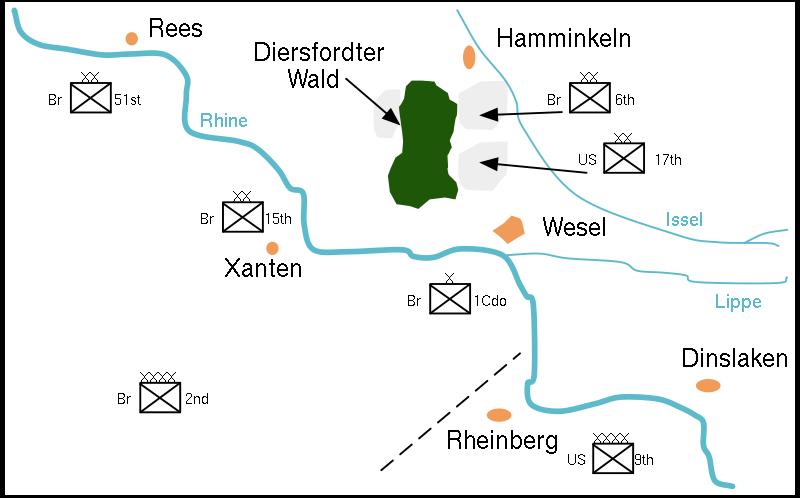
There was no operational flying on March 21st as twenty-six 233 Squadron Dakotas prepared for Operation Varsity, the Rhine Crossing, by flying to Birch airfield in Essex. The operation commenced at 06:18 on March 24th as each of twenty-four Dakotas took-off towing an Airspeed Horsa glider. KG403 was flown, as usual, by Flt.Lt Hyne with Flt.Sgt Ellis as Second Pilot, FO G.Fotheringham as Navigator and Flt.Lt Knapp as Wireless Operator. The gliders were successfully released near Wesel between 10:17 and 10:21 and the Dakotas proceeded to B75/ Nivelles to refuel. Three aircraft were hit by flak but all managed to land safely, one at B64/ Diest-Schaffen. KG403 landed at Nivelles, undamaged, and returned to Blakehill Farm the following day.
Logistics flights were resumed on March 26th with PO White making two flights to B75/ Nivelles carrying cluster bombs outwards and flak suits back to Down Ampney after the first flight. March 27th saw Flt.Lt Hyne flying KG403, with 8 other Dakotas, taking army stores to Nivelles. On 30th March, the same crew delivered army freight to Nivelles, 15,029 lbs being split between three Dakotas. KG403 and another Dakota called at Eindhoven on the way back to Down Ampney and collected 49 glider pilots.
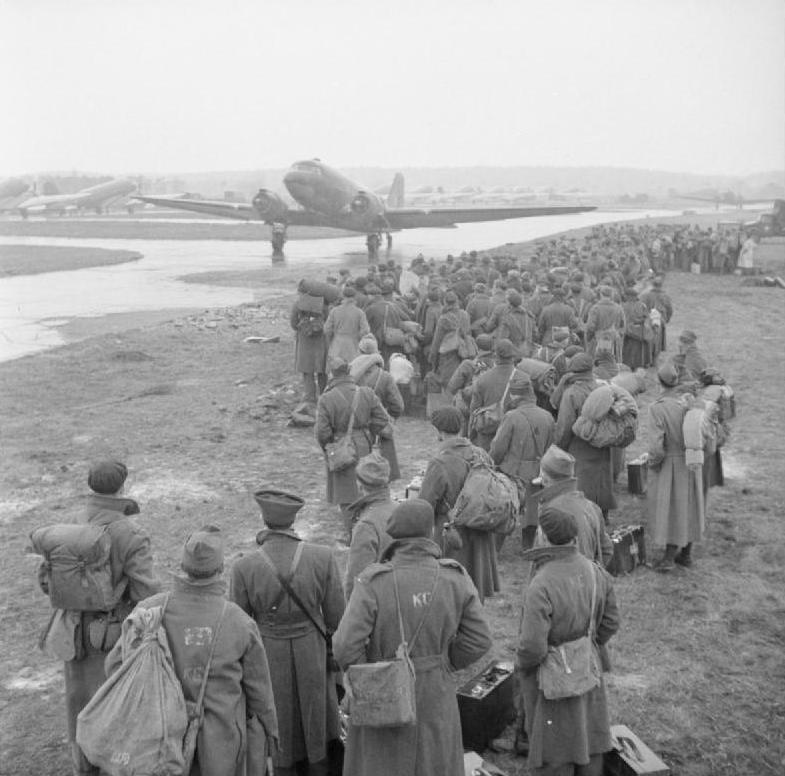
April 1945 saw KG403 flying a steady series of logistics missions combined with ex-POW repatriation flights. As the Allies pushed into Germany from both East and West, more and more prison camps were liberated. The British mounted ‘Operation Exodus’ to return ex-POWs to dedicated repatriation camps at sites like RAF Wing, RAF Westcott and RAF Dunsfold. Many of the aircraft employed were the now semi-redundant bomber force but 46 Group Dakotas also played a prominent part. April 2nd was the official start of Operation Exodus and 233 Squadron also assisted transporting French, Belgian and Russian ex-Prisoners of War, often from German prison camps to Brussels-Evere which acted as an initial assembly point. The concentration camp at Bergen-Belsen was liberated on April 15th and the Advanced Landing Ground at B118/ Celle became the airfield through which many ex-inmates were flown to freedom. 233 Squadron flew some of these flights and their Blakehill Farm neighbours, 437 Squadron RCAF, flew many more.
April 2nd: Flt.Lt Hyne’s crew was one of eight delivering passengers and their kit from Fairwood Common to B85/ Schijndel in Holland.
April 4th: Flt.Lt Hyne flew KG403 as one of four Dakotas taking freight to B78/ Eindhoven.
April 7th: Flt.Lt Barlay and KG403, one of three Dakotas taking Merlin engines to Eindhoven.
April 9th: KG403, flown by Flt.Lt Hyne, was one of twelve aircraft delivering petrol from Greenham Common to Y85/ Ettinghausen – into Germany for the first time. 233 Squadron aircraft then repatriated a total of 328 ex-POWs to RAF Wing.
April 10th: 11 Dakotas flew empty to Y30/ Le Havre- Octeville, the gathering point for ex-POWs being repatriated. Flt.Lt Hyne’s crew then flew KG403 to RAF Wing with a group of ex-POWs.
April 11th: The same crew operated KG403 on a petrol delivery flight from Greenham Common to Y-87/ Nidda before continuing to Y84/ Giessen to collect ex-POWs bound for Westcott in England.
April 12th: KG403, flown by Flt.Lt Chesney, and KG415 delivered Mosquito drop tanks to B50/ Vitry-en-Artois, returning to Down Ampney with 14 stretcher cases and 24 walking wounded.
April 13th: Pilot Officer Tozer took KG403 as one of six Dakotas delivering petrol to B108/ Rheine before transiting to the newly-opened strip at Y83/ Limburg to collect ex-POWs bound for RAF Wing.
April 17th: Warrant Officer Neal was in command of KG403 for this epic multi-leg operation. One of eight Dakotas delivering petrol to Celle from Blakehill Farm, the next sector to B56/ Brussels Evere was flown empty prior to the collection of another load of fuel for B118/ Celle. From Celle, another empty sector was flown to the newly-liberated R16/ Hildesheim. Ex-POWs were uplifted for the flight back to B56/ Evere. A positioning flight followed to B100/ Goch to collect ammunition destined for B114/ Diepholz. The Dakota was empty again to R16/ Hildesheim where a further group of ex-POWs was uplifted for the flight back to RAF Wing. The final leg was returning home to Blakehill.
April 19th: Flt.Lt Hunter commanded KG403 on another epic 7-aircraft mission to the Continent. The Advanced Landing Grounds visited were B118/ Celle, B122 (Unknown) and B150/ Hustedt with petrol and passengers conveyed. Ex-POWs were transported from Celle and Diepholz back to Brussels and Oakley.
April 20th: Pilot Officer Green flew KG403 from Blakehill to B150/ Hustedt with petrol before heading to B100/ Goch to collect ammunition for B114/ Diepholz. Fuel was then delivered to B116/ Wunstorf before the Dakotas travelled to B56/ Brussels-Evere to uplift more fuel for B150/ Hustedt. Moving on to B100/ Goch, ammunition was collected for two further flights to B114/ Diepholz. Finally, 30 ex-POWs were flown from Diepholz to RAF Wing and the Dakota returned to Blakehill Farm empty.
April 22nd: PO Wright took KG403, one of four Dakotas carrying petrol and ammunition to B114/ Diepholz. Ex-POWs were then flown to B77/ Gilze-Rijen and, some, on to RAF Wing.
23rd April: Flt.Lt Hyne returned to KG403 for a petrol delivery to B118/ Celle. The flight returning to the UK carried ex-POWs.
24th April: WO Lee delivered petrol to B114/ Diepholz before heading to B56/ Brussels with stretchers and walking-wounded. Ex-POWs were returned to RAF Dunsfold.
26th April: FO Menzies flew KG403 to Morton Vallence to collect two power units for delivery to B56/ Evere. Night-stopping at Brussels, the aircraft then flew on to B109/ Quakenbruch to collect passengers bound for B91/ Kluis. A further group of passengers was then transferred to B56/ Brussels before the Dakota returned to the UK with 25 ex-POWs.
28th April: Flt.Lt Hyne took KG403 to Croydon to collect passengers bound for Europe. Paratroops were transported to B56/ Brussels-Evere and onwards to Netheravon (some entries in the Ops Log unclear).
April 30th: The last mission of the month saw Flt. Lt Fisher delivering 5000 lbs of fuel from Blakehill to B100/ Goch.
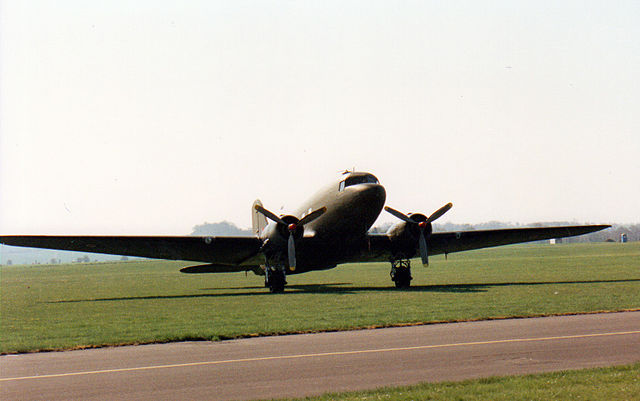
May 1945 was another hectic month for 233 Squadron as the War drew to a close. On May 2nd, Flt.Lt Hyne continued the petrol delivery flights with an 06:15 lift en route to B118/ Celle. The Dakota proceeded to R57/ Bremerhaven to collect 31 ex-POWs bound for R16/ Hildesheim prior to returning to RAF Wing. The following day, PO Diamond in KG403 delivered more petrol to Germany, returning with parachutists.
PO Wright was in charge on the 4th May for a full freight flight to B56/ Brussels-Evere. Another load of freight was carried on to B114/ Diepholz and thirty ex-POWs returned to Brussels. Multi-leg trips were back on the roster on May 6th when Sgt.Butcher hopped empty to Croydon to collect 3390 lbs of freight destined for Brussels. Overnighting at Evere, KG403 flew on to Copenhagen with the same freight load the following day. Flying on empty to B156/ Luneburg, six stretcher cases and sixteen walking wounded were embarked for transport to Down Ampney via a stop in B56/ Brussels-Evere.
As the War ended, KG403 was still airlifting petrol to Europe. PO Green took-off from Blakehill Farm at 08:50 on May 8th en route to B56/ Brussels with 5016 lbs of petrol. The Dakota continued to Copenhagen with the fuel before returning to Luneburg empty. From B156/ Luneburg, KG403 returned to Down Ampney with casualties and passengers.
Flt.Lt Priestley was in command of KG403 on 13th May, heading empty to B56/ Brussels-Evere to collect 32 ex-POWs bound for Dunsfold. Two subsequent flights carried 32 and 30 ex-POWs to Dunsfold and Wing. Flt.Lt Hyne returned to KG403 for a similar mission spread over the 14th and 15th of May. The first leg was flown empty to Matching in Essex. Troops were then conveyed to B56/ Evere followed by three lifts of ex-POWs to Oakley and Tangmere. Continuing on 15th, Flt. Lt Hyne and KG403 delivered SHAEF freight to B160/ Copenhagen, continuing empty to B158/ Lubeck to collect 31 Belgian ex-POWs inbound to B56/ Brussels. A further fifteen ex-POWs were airlifted home to Dunsfold.
FO Clarkson’s crew were on a petrol flight to Brussels on May 17th before transporting 5000 lbs of clothing to B154/ Reinsehlen. From there, they flew an empty sector to B156/ Luneburg to collect troops bound for Bovingdon and Netheravon. On May 18th KG403, commanded by FO Diamond, lifted off at 08:10 heading for B156/ Luneburg with passengers before returning to Netheravon with 25 passengers and their kit. Flt.Lt Hyne flew KG403 empty to B56/ Brussels-Evere on May 19th in order to collect a load of freight destined for B156/ Luneburg. From there thirty US ex-POWs were transferred to Y30/ Le Havre Octeville and three US aircrew flown back to Blakehill. FO Green flew KG403 to B156/ Luneburg with fuel on 21st May before making the shoprt hop to Flensburg. The Dakota then returned empty to Luneburg before transferring 28 ex-POWs to Brussels. Thirty-two ex-POWs were then flown home to Oakley. A similar operation on May 29th saw Flt.Lt O’Flynn positioning KG403 empty to B56, collecting freight for delivery to Luneburg and then returning to Dunsfold with ex-POWs via a couple of intermediate stops. KG403’s last flight in May involved Flt.Lt Hyne’s crew taking the Dakota empty to Boreham where 4900 lbs of freight was loaded for delivery to Oslo. The flight to Norway was via an intermediate airfield for fueling and the return, carrying freight and passengers, made to Northolt via Swanton Morley in Norfolk.
June 1945 was the last month of 233 operations from Blakehill Farm. On June 1st, Flt.Lt Hyne flew KG403 to B78/ Eindhoven with freight. After continuing empty to B160/ Copenhagen, the Dakota collected 22 passengers for Saltby in Leicestershire. The same crew delivered freight to the Continent again on June 3rd, returning to Dunsfold with ex-POWs. Flt Lt Hunter was in command of KG403 on June 5th when the Dakota departed Blakehill empty en route to Boreham in Essex. Freight was picked-up for delivery to Oslo (possibly via Luneburg) with the Dakota visiting both of the Norwegian capital’s airports. KG403 then shuttled empty to Copenhagen and on to B156/ Luneburg where 9 Displaced Persons were collected for transport to Brussels. The final leg home to Blakehill was flown empty. On June 8th Sqdn Leader Daniell used KG403 to transport 233 Squadron equipment from Blakehill to the Squadron’s new home at Odiham. The next day FO White skipped KG403 from Blakehill Farm to Down Ampney to collect 5143 lbs of freight heading for Istres, Marseille. The return flight landed at Odiham and future operations were from there. Flt.Lt Hyne was in command of KG403 on June 13th for a flight to B58/ Brussels-Melsbroek. The outward sector was empty and the return carried Canadian troops to Blackbushe. A further twenty troops were picked-up on the Continent during the afternoon and, again, returned to Blackbushe. Passengers were also carried on June 14th when Flt.Lt Bentley carried 16 from Hendon to B168/ Hamburg, flew empty to B61/ Sint Dinijs and returned to Blackbushe with more passengers. On June 16th, Flt.Lt Hyne flew KG403 empty to Croydon to collect passengers for B116/ Wunstorf before also transporting passengers to B156/ Luneburg where casualties were embarked for transport to Down Ampney. The next few days involved KG403 flying freight between Northolt, Down Ampney and the Continent. On 17th June Sqdn Leader Daniell flew the Dakota empty to Northolt to collect 4500 lbs freight destined for B168/ Hamburg. Transiting to Lubeck, 25 Displaced Persons were collected and flown to Brussels-Evere before KG403 returned empty to Odiham. On 18th, it was Flt.Lt Hyne’s turn to transport equipment from Northolt to B118/ Celle. On 19th June, WO Maplecroft operated the Dakota empty to Down Ampney, collected 5000 lbs of freight for B116/ Wunstorf and then carried one passenger onwards to B156/ Luneburg. Fourteen passengers were transported back to Blackbushe.
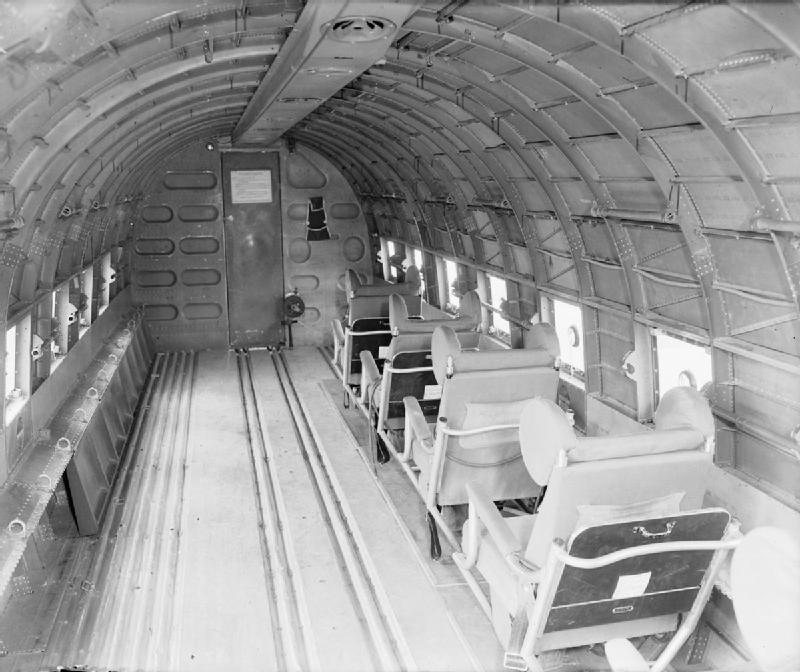
22nd June saw KG403 on an early 06:40 lift from Odiham flying empty to Down Ampney. A 4500 lb shipment of food was loaded and transported to R85/ Munich (possibly R89/ Plzen, the log is indistinct). Flt Lt Hyne flew the Dakota empty back to Odiham via Brussels and Down Ampney. Another interesting mission involving Flt Lt Hyne’s crew and KG403 took place on June 23rd when foreign currency was transported to the Continent along with two escorts. The aircraft returned via B75/ Nivelles. The Hyne crew operated a double lift of army personnel over June 26th and 27th. Flying empty to B58/ Melsbroek, twenty-five army personnel were collected for transport to Dunsfold. This was repeated with a second batch of 25 troops. The Dakotas could transport this number of troops with their equipment; 30 to 35 ex-POWs could be transported as they generally had very little luggage/ equipment (although some apparently managed to liberate souvenirs from Germany and Italy!). Sadly, as Jack Sproule the CO of 437 Squadron commented, some Dakota flights accommodated 50 ex-concentration camp prisoners as they were emaciated and had nothing.
PO Tozer was at the controls of KG403 on June 28th for a flight from Croydon to R14/ Detmold with freight and passengers. Positioning empty to B56/ Brussels, Displaced Persons were collected for transport to B156/ Luneburg. French and Belgian DPs were then transported back to B56/ Brussels-Evere. FO J.McAllister’s crew was allocated KG403 on June 29th. Flying empty to Hendon, 15 passengers were transported to B116/ Wunstorf. Twenty-four casualties were collected from another base and delivered to Brussels. Six passengers were returned to Northolt. On the last day of the month, PO G.Wright flew KG403 empty to Dunsfold to collect the Second Army cricket team who were bound for B156/ Luneburg. Flying on to B164/ Schleswigland empty, one passenger was picked-up for transport to B116/ Wunstorf. The Dakota returned empty to Odiham via B56/ Evere.
On July 8th KG403 was flown empty to Greenham Common by FO Alford. 4538 lbs of freight was uplifted for Ab2/ Rheims. The aircraft returned to base empty via B78/ Eindhoven. By July 10th, KG403 was being logged by its ID letters ‘UM’ and Wing Commander Mellor seems to have flown her on a flight from Northolt to Berlin with four passengers. Returning empty to Hamburg, 24 passengers were embarked for the flight back to Odiham. WC Mellor relinquished command of 233 Squadron a few days later on July 14th as training for the transfer to India commenced. On July 11th Sqdn Leader Mackie’s crew flew KG403 from Odiham to Berlin Gatow with 4980 lbs of freight. Another load was then delivered to B168/ Hamburg before the Dakota returned empty, firstly to Gatow and, subsequently, to Odiham. KG403’s last operational mission for 233 Squadron was probably on July 13th when Flt.Lt Coulson flew from Northolt to R14/ Detmold with freight, continued empty to Y56/ Monchen Gladbach and then flew passengers to A54/ Le Bourget before returning to Odiham.
Training for operations in the Far East commenced on 16th July. Sqn.Leader Daniell flew KG403 from Odiham to Broadwell for glider-tow practice. FO Williams also used 403 for this training on 16th before Flt.Lt Moulder and FO Spinks took over on the following day for local formation flying. Flt.Lt Wharton also flew some glider tow lessons in KG403 on July 18th and followed these with supply dropping practice. The latter was to prove useful in India although the glider training, carried-out on 18th with Flt.Lt Hill at the controls of KG403, would not be of any further use. FO Williams took part in formation paratroop dropping later on 18th July.
KG403 was air-tested by PO Wright on 22nd July. This may have been prior to her departure for India during mid-August although she is not recorded as being part of the second, third or fourth groups of Dakotas despatched to India. However, KG403 could, conceivably, have been part of the first or fifth groups of five aircraft sent by 233 to Tulihal in India where the RAF squadron replaced the Canadian 435 Squadron. In parallel, 48 Squadron RAF flew their Dakota complement to India/ Burma to replace 436 Squadron RAF. In both cases, the RAF aircraft returned with the Canadians, relocating to their new homes in Britain. While KG403, as a 233 Squadron Dakota, probably returned to Odiham with 435 Squadron, it was subsequently transferred to 436 Squadron at Down Ampney.
The Canadian government is reported as having taken ownership of KG403 on 16th April 1946 and, around then, the Dakota probably returned to Canada to be allocated to the RCAF unit at Mossbank on July 20th 1946 with the RCAF designation Dakota IIIR (1).
(1) Data on KG403 from Air Britain’s DC-1/2/3: the first seventy years by Jennifer Gradidge.

435 Squadron traveled to Britain slightly earlier than 436 Squadron and, by the time 436’s last flight of Dakotas arrived in England on September 15th 1945, 435 had reformed at Odiham. 435 had a full complement of Dakotas but remained short of ground crews. Some of the ACSEA aircrews had returned to Canada for demobilisation and many of the maintenance staff also wanted to go home. RAF ground crews had been withdrawn, so the RCAF squadrons were left short of support and could only field a limited number of Dakotas.
By the end of October, both Canadian squadrons were flying operationally after local and european training for the ex-ACSEA crews and also the new aircrews which had been mobilised from Canada. Although the operational status of the Dakota IIIs and IVs was much better, there doesn’t appear to be any sign of KG403 flying operationally with either squadron until the end of November 1945.
On November 23rd, KG403 departed Down Ampney at 10:40 flying a special trooping flight for 436 Squadron to Copenhagen- Kastrup. The Dakota continued to Oslo Fornebu before returning to Boreham in Essex with 20 passengers on the afternoon of November 26th.
Pilot Officer Parder was at the controls on November 28th for another ‘special’ – as opposed to 436’s regular scheduled flights to Europe. KG403 was flown from Down Ampney to Croydon, presumably to pick-up personnel, and then on to the RCAF/ RAF airfield at Buckeburg in Germany. The return followed the same route, again with passengers. On November 30th, KG403 set-off on a longer-distance mission, starting-off at Blackushe where, after the short hop from Down Ampney, the Dakota went ‘technical’. The following day, all problems remedied, the Dakota departed for Marseille with freight. The Dakota flew north again on December 2nd taking passengers to Paris/ Le Bourget. Returning to Blackbushe with passengers and freight, KG403 departed for Marseille- Istres with passengers again on December 4th 1945. The Squadron’s Operations record Book notes that the Dakota was diverted to Naples with passengers and mail, although it seems possible that this was subsequent to arriving at Istres and before returning to Britain. Either way, KG403 departed Istres on December 5th, bound for Naples but, along the way, diverted to Ajaccio*. Continuing to Naples, 18 passengers and mail were collected ready for the return flight to Istres on 6th December. The northbound routing continued to Le Bourget before heading to Blackbushe the following day. Indeed, KG403, had probably been briefly detached as the ‘Blackbushe Aircraft’ but returned to Down Ampney on December 7th. A further detachment followed, with 403 joining 436 Squadron’s Biggin Hill detachment on 10th December. The Kent airfield hosted four 436 Squadron Dakotas, five crews, for operations dedicated to supporting the Canadian army. Initially, this involved KG403 flying day return services from Biggin to Amsterdam’s Schiphol airport on December 10th, 13th, 14th, 15th and 16th. The flight on 15th was diverted to Valkenburg near Maastricht in SE Holland owing to poor weather. KG403 lifted from Biggin at 10:20 on December 18th bound for Amsterdam with steel tubing and ‘soldiers comforts’. The flight continued to Brussels, probably Evere, to uplift seven passengers and mixed freight destined for Biggin Hill. December 20th saw KG403 flying the same 450 mile triangular route with 19 outbound passengers and 13 returning from Brussels to Biggin. The route was reprised on December 20th and 22nd but, on 23rd, the routing was a 586 mile service from Biggin to Munster, returning via Amsterdam. Flight Lt Dempster was in command for a Christmas Eve flight delivering 14 passengers from Biggin to Brussels, transporting nine personnel onwards to Amsterdam before returning to Kent with six passengers. Dempster and KG403 continued home to Down Ampney for Christmas on the same evening, returning the 105 miles to Biggin Hill on Boxing Day 1945.
Following Christmas, it was back to regular destinations with Biggin Hill to Brussels and Amsterdam routes flown on December 27th and 29th. The latter flight stopped-off short of home at Manston in East Kent owing to poor weather. The hop to Biggin Hill was made the following morning, December 30th, and KG403 was ready for FO Olson to fly her on a ‘special’ flight to Germany. The Dakota carried four passengers to Bremen, German captives who would be witnesses at the Nuremberg trials and their guards, plus 4590 lbs of freight. The Dakota returned to Blackbushe with 22 passengers.
* The type is blurry in the RAF record; it might read Ajaccio which was a Corsican air base recently upgraded by the USAAF. Alternatively, the name looks more like Aghione although this ex-USAAF was probably officially closed by 1945. In either case, KG403 probably stopped-off in Corsica.

KG403 isn’t logged as commencing flights from the Biggin Hill detachment until mid-January 1946. FO Nicholls captained ‘KN403’ to Ahlhorn, Germany, on 15th January, empty on the way out, returning via Amsterdam loaded with 12 passengers and freight on the return. The mixed passenger/ cargo services to Ahlhorn and Amsterdam continued on 16th, 17th and 18th of January as well as a special flown by Squadron Leader Milne on 22nd. On 24th, FO Storey varied the theme, flying KG403 from Biggin to Brussels Evere and onwards to Amsterdam, returning directly to Kent, with freight in both directions. R40/ Bremen was the destination on 27th with 5140 lbs of mail as the payload. A mixed passenger/ freight service to Evere and Amsterdam followed on 29th before KG403 returned to Bremen on 30th January. The 680 mile round trip carried passengers outwards, freight on the return. The last day of the month involved transporting 21 passengers from Biggin to B56/ Evere, eleven onwards to Ahlhorn and thirteen on the home-bound sector.
February began with an 11:55 lift from Biggin Hill with nine passengers bound for Valkenburg in Holland. Three passengers were carried on the return leg. Flt. Lt Larter was in command of KG403 for the 4th February schedule to Bremen, flown empty on the outbound sector, carrying twenty passengers on the return. On February 7th, Flt.Lt Anderson kicked-off a couple of two-day missions for KG403: 12 passengers and their baggage were transported to Bremen, eight passengers on to the night stop at A54/ Paris Le Bourget. Seventeen passengers were flown back to Bremen the following day and twenty back to Biggin Hill the same afternoon. Flt Lt Larter repeated this schedule on February 11th/ 12th. On February 16th it was FO Parker’s crew’s turn to fly KG403. The routing was to two stations on the Continent which had strong RCAF connections: Rostrop and B174/ Ueterson. The former had been the largest Luftwaffe air base in Northern Germany but, following capture by Canadian and Polish forces in the last days of WW2, it had been largely demolished to leave only one runway and a hangar. 436 Squadron RCAF visited it frequently during Spring 1946. RAF Ueterson, close to Hamburg, was, in February 1946, home to RCAF’s Spitfire outfit, 443 (Hornet) Squadron. KG403 lifted from Biggin Hill at 08:30 outbound for Bremen. Unfortunately, an engine failure during the first 30 minutes or so of the flight led to a return to Biggin Hill. All had been remedied by 22nd February, enabling an 08:59 departure for Rostrup with 4505 lbs of freight. The Dakota remained on the ground at Rostrup until February 24th when she departed for Brussels with 6 passengers and 2200 lbs of freight. The flight continued home to Biggin with one passenger and 2198 lbs of freight. 25th February involved Flt.Lt Kenworthy’s crew taking passengers on the schedule to Valkenburg in Holland, on to Rostrup and home by the same routing. On March 1st Flt.Lt Larter’s crew flew KG403 on a special flight to Brussels via Rostrop. The Dakota seems to have remained on the ground in the Belgian capital until March 7th when Flt.Lt Larter returned to Biggin Hill with 363 kgs of freight, 15 passengers and their baggage. KG403 ‘M’ then disappears from 436 records for a few days, reappearing on 22nd March for a scheduled flight, C2, with passengers between Down Ampney and Ueterson, continuing empty to Buckeburg before returning to Down Ampney on 23rd March. This was clearly a guest appearance, as KG403 was back flying from Biggin Hill on 26th March when FO Desprese flew army supplies from Biggin to Rostrop, returning to Odiham with 9 passengers before hopping back to Biggin Hill. 29th and 30th March involved KG403 flying the Rostrop schedule with, respectively, freight and mail.
The detachment had been set-up to service Canadian army needs and aircraft loading at Biggin Hill had been arranged by the army. The aircrews had enjoyed excellent mess facilities and food and the number of aircraft assigned to the Kent airfield had doubled from four to eight by March 1946. The crew number had doubled too with ten crews flying regularly, but all things must end and, on April 13th 1946, the Biggin Hill operations ended and the Dakotas returned to 436’s main base, now at Odiham, Hampshire. KG403 may well have moved towards her new future in Canada around this time with her stewardship being noted as being ‘The Canadian Government’ as from April 16th 1946 (1). Her first home in Canada is recorded as Mossbank where she reportedly arrived on July 20th 1946. 436 Squadron’s Dakotas also made the Atlantic crossing between June 2nd and 22nd 1946 so it is possible that KG403 was part of that journey. 436 Squadron aircraft traveled to Rockcliffe initially but KG403 may have done this before moving on to Mossbank for reallocation within the RCAF.
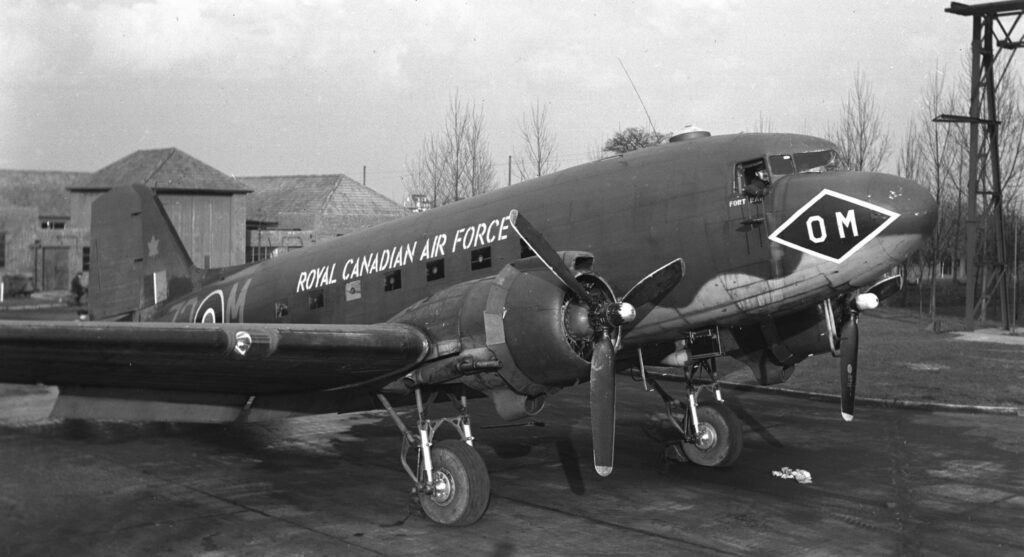
Mossbank was the RCAF’s #2 Bombing and Gunnery School but records show that it was closed in August 1944. It is possible that it was used as a storage/ allocation facility prior to the assimilation of aircraft into the peacetime air force.
KG403 is next recorded (1) as being with the Central Air Command at Clinton, Ontario on 12th November 1948 and she appears to have remained there until 20th May 1953 when she was transferred to the Air Transport Command HQ’s Piston Flight. On April 21st the following year KG403 moved to the Air Material Command at Rockliffe, near Ottawa. In June 1955 there was another move and a change of commands from Air Material to the Training Command base at Winnipeg. Based at #2 Air Navigation School as from 27th June ’55, she remained with them for several years before moving successively to several Winnipeg-based training units. The aircraft was signed-up to #2 Air Observer School on 29th March 1961, the Air Navigation School again on 26th May 1964 and the Central Flying School on 8th June 1967. She moved from Manitoba to a new home at 129 Acceptance and Ferry Flight at Trenton, Ontario on 14th August 1968. The following year, a move to 1005 Technical Services Dept at Saskatoon back in Saskatchewan on 19th September 1969 preceded a new identity, 12920, in June 1970. The new serials were allocated to around seventy Dakotas during 1970 but this didn’t disguise that the Canadian Air Force were steadily disposing of their Dakota fleet and KG403/ 12920’s days in military service were drawing to a close.
Civilian Career:
Maritime Aircraft Overhaul and Repair Ltd of Moncton, New Brunswick, was a company which frequently bought surplus aircraft from the Canadian Air Force. Owner Dave McEwen had previously bought both RCAF Sabres and Sea Furies from the air force storage facility at the neighbouring Scoudouc airfield. He was linked with Targetair, a remote gunnery target outfit. The company purchased an ex-CAF Dakota in June 1970 and sold it successfully on the US market. This was followed by a batch of eleven airframes delivered to Moncton in December 1971 and civilianised with Canadian registrations CF-BKP to CF-BKZ. Our Dakota, KG403/ 12920 was the first of this batch, CF-BKP, and was moved onto the US register as N107AD in May 1972. Maritime went on to convert a further three CAF Dakotas in May 1973 and Dave McEwen bought a further example in November 1974.
The ‘AD’ of N107AD’s registration stood for Aerodyne, a Washington State-based contractor which had been formed by ex-Northwest Airlines pilot Jack Volkel in 1965. their business plan was to provide DC-3 ratings, maintenance and training as well as charter facilities and a smoke jumping capability. Volkel had taken advantage of Air West’s disposal of DC-3s in the late 1960s and took-on eight of the west coast airline’s fleet. This included the D-Day Squadron’s ‘Placid Lassie’ (see separate thread) N74589. The fleet operated from Renton Field, Washington, and was busy in the early 1970s. N107AD was added in May 1972 and remained with the operation for nine years. However, business tailed off in the latter part of the 1970s and many of the fleet were parked-up at Renton from 1974 and gradually sold-off until the Company finally ceased trading in 1985. By then, N107AD had moved to an Alaskan-based fish transporter called Stanelco Inc which took delivery of the aircraft at Juneau in Autumn 1983. The company had also owned C-47 N8061A since October 1979 although this had been leased to Seattle-based operator, Salair, in 1982.
Salair had been formed by the Salerno family when brothers Bruce and Paul bought a C-47 in May 1980. Both had worked flying fish cargoes in Alaska and, upon graduating from college, decided that they could make a living doing the same. Bruce had experience flying DC-3s and Paul was a trained aviation mechanic who was also a pilot. Both parents had also been involved in the airline industry and, upon discovering that the kids had bought an aircraft with no spares package and now had no spare cash, were far from amused. However, the operation flourished during the fish-transporting summer season and, eventually, developed as an air courier business to tide them over the winter periods. Some of their C-47 fleet was leased, some bought, and they eventually operated a dozen of the low cost freighters. Stannelco’s N8061A was leased from October 1982 and subsequently purchased by Salair in 1987. Meanwhile, Stannelco had bought N107AD in 1983 to cover for the leased N8061A. Salair then bought N107AD as well in November 1985 and the C-47 returned to Renton Field.
Salair reported that they bought C-47s for around $125,000 which meant that they were not capital intensive and could sit around on Alaskan airstrips and beaches awaiting cargoes of fish. The short-field performance of the Dakotas meant that they could land on gravel roads, primitive airstrips and even beaches. The tail wheel undercarriage and large cargo door meant that they were easy to load with fish crates. As the courier business developed, Salair offered the larger forwarders the capability of delivering their parcels the final miles to their customers who lived besides basic outback airstrips. The airline also flew Convair CV440s which suffered two serious crashes. A Salair C-47, N3433Y, had crashed owing to engine problems at Spokane in 1994 and, the following year, a CV440 flying a charter to the Dominican Republic also suffered a crash with fatalities. In 1996, a second CV440, flying with Paul Salerno as part of the crew, crashed on a night approach to Spokane, fortunately with no fatalities (3). At the end of 1997 the Salerno family were approached by Air Alaska Cargo who wanted to buy-out the Salair freight operation. The airline was merged into the larger company’s operation with the two brothers continuing to work with the courier and freight flights (4). By then, the C-47s had moved-on with some going to Alaska’s Desert Air and N107AD and N2025A, both ex-Aerodyne aircraft, moving east to Business Air in Vermont in December 1986.
(3) From the Bureau of Aircraft Accidents archives.
(4) Details from the Spokane Review of 23/2/98.
Business Air of Bennington, Vermont, could trace a history back to 1957 as a charter operation but, in 1970 under the ownership of David Corey, adopted a new business plan with an alternative name. Marketed as ‘Air Now’ the company provided parcel delivery services from the large north-eastern city hubs to smaller, more obscure airports in New England and the east coast of the USA. Their clients were the big courier companies serving the airports at Burlington, Niagara, Albany and Hartford. Despite the new name, most references over the years are to ‘Business Air’ and it was under this name that they took over fellow Vermont C-47 operator Northern Airways in the summer of 1986. Northern had operated six Dakotas with the registration suffix ‘NA’ from South Burlington during the mid-1980s as part of the convoluted Vermont aviation scene (**See the separate item at the end of this thread **). Interestingly, while their aircraft were also involved in cargo and courier work, at least four of them were painted in WW2-style camouflage colours. With ownership passing to Business Air in July 1986, five of them commenced operations with their new proprietor while the sixth, N53NA, appears to have been sold to Four Star Aviation. The Northern C-47s were joined by the two ex-Salair C-47s N107AD and N2025A, both of which retained their ‘civil’ colour schemes. The parcels business appears to have flourished with a long-term contract with UPS but replacement of the C-47s commenced in 1992 and continued until 1995. Flying Embraer Bandeirantes, the Company survived the first decade of the 21st Century but collapsed during the 2008 economic crash and was eventually absorbed into UPS. N107AD had been the first Business Air Dakota to depart when, in March 1992, she was sold to Champlain Enterprises of Plattsburgh, New York, where she was subsequently joined by her comrade from Vermont, N59NA.
The new owner of N107AD was Champlain Enterprises of Plattsburg, New York, a holding company for various aviation enterprises. The CEO of Champlain, John Sullivan, had founded a company called Commutair at Platsburgh in 1989 with Jim Drolette and Tony von Elbe. CommutAir operated Beech 1900s on behalf of United Airlines commuter division and later went on to fly Embraer ERJ-145s. Arriving at Champlain on 25th February 1992, the Dakota was re-registered N700CA in May 1992 and, from April 5th 1995, was operating with Champlain Air. By January 23rd 1997 the aircraft was carrying the name ‘Mary Lou’ when seen at Tamiami Kendall Airport. The Dakota is recorded as being leased by CommutAir director Jim Drolette and, beneath the cockpit window, carried the crew titles Jim Drolette and Tony von Elbe.
During the next few years, N700CA was evident around the east coast of the USA with appearances at Fort Lauderdale, Florida, on April 10th 1998 and back at Plattsburg in the snow on February 3rd 2005. She carried a smart polished-silver finish with a grey ventral section and blue cheat line and fin stripes.
Champlain had also bought an early model DC-3 and a C-53, both of which had flown for the defunct Eastern Express. they joined the fleet as N922CA and N122CA on 7th July 1992. On 13th December 1995, the numbers of C-47s increased again with the arrival of fellow ex-Business Air veteran N59NA (once G-AKNB). N700CA was noted at Oshkosh in July 2006 and frequently appeared at home base Plattsburgh, Geneseo (New York) and Lakeland Linder airports during 2008 and 2009. She was also noted at Portland’s International Jetport in 2009 but, at some stage in 2010, she was sold on to Basler. Fellow Champlain Douglas N922CA, named Priscilla, had been sold on January 14th 1999 and joined the Breitling ‘Round the World’ project as HB-IRJ before moving to turkey where she remainstoday as the display aircraft ‘Turkish Delight’. N59NA, named ‘Bones’, moved on to BGAviation in November 2007 before arriving at Basler’s Oshkosh facility in 2014. She has since been converted to a BT-67 and moved to Canada as C-GOOU of White Desert.
N700CA was noted at Oshkosh on 24th February 2013 and, by July 31st, was parked-up on the Oshkosh hardstanding. While still looking very tidy, she had been pushed back onto the grass by July 2015 and, a year later, was beginning to look a little forlorn.
Photographs taken in August 2020 show little change, although an aileron had been removed, and her future began to look quite bleak. Fortunately, she was selected to become Basler’s BT-67 airframe #71 and was moved into the hangers in 2022. It will be interesting what the future holds for her – perhaps she will make it to somewhere warmer than Canada and the northern USA, her home for the last seventy-seven years. Equally, the Canadian Arctic or the Antarctic could be on the agenda….
Bennington and Burlington C-47 chronicles:
The ownership and operation of many historic aircraft based in Vermont appears to have been convoluted during the 1980s. Northern Airways operated for only a short time but their six Dakotas with ‘NA’ registration suffixes have interesting and varied histories. N54NA started the ball rolling in November 1984 and N58NA completed the batch in August 1985. By 28th July 1986, Northern had merged into fellow Vermont operator Business Air and had possibly maintained an association before that date. Many of the Northern Dakotas were sprayed in WW2 camouflage colours which may also reflect an affiliation with the Vermont historic aviation fraternity. Four of the aircraft had also been owned by the British aviation movie consultancy ‘Aces High’ and, as these were the C-47s with the olive drab colours, this probably indicates that they had been gathered together for a movie (possibly ‘The Dirty Dozen: the Next mission’). However, that’s not the whole story: Mike Woodley owned the British Aces High company but there was also Aces High USA which had links to Consolidated Aviation Enterprises of Burlington, Vermont, whose proprietor was a colourful character named George Dean Martin. He owned the ex-Catch 22 B-25 Mitchell N1024B which was operated in the UK by Aces High during the late 1980s. Aces High had supplied Martin with a handful of ex-Swiss Air Force DH Venoms in 1984/ 85 and Martin had also imported European MIGs and Fouga Magisters to his South Burlington base. Warbirds Inc was an associated company and operated from Burlington and Middlebury.
Dakota N53NA: Registered to Northern Airways on April 5th 1985. No links to Aces High; sold to F.J.McCarthy of the British Virgin Islands, possibly before Business Air took over.
Dakota N54NA: An ex-Danish Air Force C-47 bought by Aces High and seen at Duxford, Cambridgeshire, in April 1984 as G-BLDI. The aircraft was registered to Northern Airways on November 1st 1984 but was seen passing through Reykjavik in USAAF-style camouflage on June 20th 1985. She operated with Northern in the military colours and passed to Business Air on July 28th 1986. Last in regular service in 1990, she was sold to Neil Stalder of Jet Air Express, El Paso, Texas, on July 3rd 1995 and crashed in New York State during the delivery flight.
Dakota N56NA: Joined Northern before the others, had no links to Aces High and may not have operated in camouflage. It probably moved on to Business Air briefly but now resides in a museum in Montelimar, France.
Dakota N57NA: A similar story to N54NA – an ex-Finnish Air Force aircraft, she was registered to Aces High as G-BLXW on 19th April 1985 and to Northern Airways on May 2nd 1985. Operated by Burlington Northern Air Freight, presumably an arm of Northern Airways, she passed to Business Air, after the merger, on 22nd August 1986. Withdrawn from use at Burlington in June 1994, she was sold to Allied Air Freight and was later converted to a BT-67 by Basler. She operates today (August 2023) as C-FMKB with Ken Borek.
Dakota N58NA: Another ex-Finnish Air Force Dakota which, as G-BLXV, joined Aces High on 19th April 1985. Sold to Northern Airways, she was registered on 29th August 1985 and also operated in a military paint scheme. Moving to Business Air on July 28th 1986, she was sold on to Park Leasing in September 1994 and, subsequently, to Saber and First Flight Out.
Dakota N59NA: One of my favourite DC-3s from British United days, this Dakota was a veteran of 512 Squadron RAF where it had served as FD789. With BU(CI)A, she was G-AKNB and passed through several owners before reaching Aces High on 29th January 1982. Restored to her old RAF camouflage colours and serial, she had appeared on film for them in ‘The Dirty Dozen: the next mission’. Sold to Northern Airways on July 22nd 1985, the Dakota continued to operate in military colours and passed to George Dean Martin’s Consolidated Aviation Enterprises in February 1986. Nonetheless, N59NA is recorded as passing to Business Air on July 21st 1986 upon their acquisition of Northern Airways. The C-47 then passed on to another George Martin company, Warplanes Inc of South Burlington, Vermont on 18th September 1989. Eventually, she was sold on October 20th 1992 to another Vermont owner, Jack Donney of Middlebury, before joining N107AD at Champlain Air in December 1995. Moving to Bga-Viation on 30th November 2007, she was repainted in USAAF colours with 3J-B codes and the name ‘Bones’ by 27th July 2010. Basler bought the Dakota on 7th November 2014 and, almost four years later, she emerged as BT-67 N141PR with a new CofA issued on 17th September 2018. Just over a year later, the US registration was cancelled with N141PR being sold in Canada and re-registered C-GOOU. Since then, she has had a whole new lease of life with Kenn Borek Aviation whose speciality is arctic and antarctic operation. In November 2021 the Dakota operated in the Antarctic, during August 2022 she was fueling conspiracy theories as she flew magnetometer surveys over ‘Area 51’ , Nevada, and currently (August 2023) C-GOOU has been operating in ‘White Desert’ titles over Northern Manitoba from picturesquely- named strips such as God’s Lake Narrows. But I digress……
Also diverging from the straight & narrow, Aces High, Northern and Business Air had registered an ‘earlier’ N59NA in the shape of an ex-Finnish Air Force C-47 purchased by Aces High. Registered G-BLYA on 19th April 1985 (along with G-BLXV, see earlier), she was nominally registered as N59NA to Business Air on 30th May 1985 – i.e. before Business Air had merged with Northern. This manoeuvre was reportedly in order to obtain a Norwegian CofA and the Dakota never operated for any of the Vermont companies. She now flies as LN-WND for a Norwegian preservation group.
George Dean Martin, whatever his links with Northern Airways, maintained an interest in old warplanes and his import of MIG 21s spawned a sideline brewing vodka…in their hangar. The MIG 21 Vodka proved even more dangerous than flying the ex-Hungarian Air Force fighters when the distillery blew up destroying a large cache of spares with it. The neighbours can’t have been impressed by this incident and his fellow South Burlington aviators proved even less happy when, in 1991, they discovered that specialist aeronautical tools which should have been in their hangar had disappeared. Metro Air North East accused George Dean Martin’s Warplanes Inc of misappropriating the equipment, the courts of Vermont agreed and Martin went to jail for 15 months. Various appeals based on technicalities went on for several years. Even more tragically, George Dean Martin was involved in a fatal 4th July sailing accident in 2002 and was, again, sentenced to a jail term. More recently, he has been reported to be writing his memoirs while living on a houseboat in Florida. Likely to be an interesting read, it may cast further light on the days when Aces High delivered a fleet of C-47s to a small operation in Vermont.
Basic aircraft data from Air Britain’s ‘DC-3- the first 70 years’ by Jennifer Gradidge. Additional information from US newspapers, Vermont State Court records, information forums.
Hits: 233
